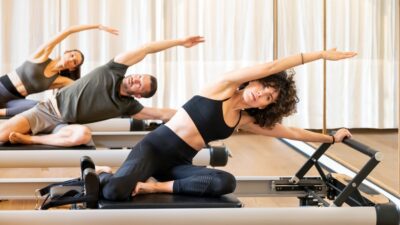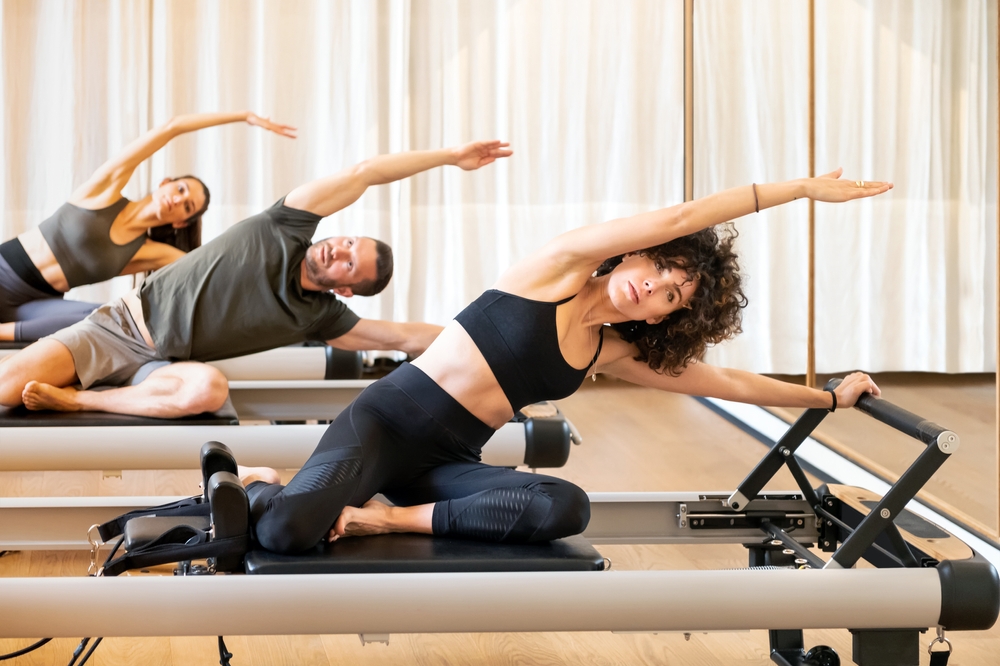



In this article, you’ll learn what is Reformer Pilates and many other useful things.
The best qualification as a Reformer Pilates instructor means establishing a strong foundation for a successful career. The Reformer Pilates method has gathered much recognition for its impact on physical health.
With its versatile resistance springs, this method engages your entire body, promoting strength, flexibility, and coordination. Improve core stability, enhance body awareness, and reduce the risk of injuries.
Ideal for rehabilitation or any fitness level, the Reformer can be adjusted to meet your specific needs. Beyond physical benefits, Reformer Pilates offers stress reduction and mindfulness.
The Pilates Reformer is a highly versatile piece of equipment that adds resistance to the Pilates repertoire through the use of springs.
Unlike traditional Mat Pilates exercises performed on a mat, Reformer Pilates engages the entire body in a dynamic and controlled manner. The springs provide resistance that requires individuals to push and pull against them, activating multiple muscle groups simultaneously.
This comprehensive approach ensures a well-rounded workout that targets not only the core muscles but also the peripheral muscles, such as the arms and legs.
The Pilates Reformer is a highly versatile piece of equipment that adds resistance to the Pilates repertoire through the use of springs. This unique feature enhances the benefits of Pilates and offers a range of advantages for practitioners. Anne Bertram, a well-respected Pilates expert from Structural Elements, emphasizes the following benefits, which is incredible that nobody highlighted before in such details:
Full-Body Engagement: The Pilates Reformer engages the entire body, targeting not only the core muscles but also the peripheral muscles such as the arms and legs. This comprehensive approach ensures a balanced and well-rounded workout that promotes overall strength, flexibility, and coordination.
Improved Strength and Flexibility: By working against the resistance provided by the springs, the Reformer Pilates exercises promote muscular strength and endurance. The controlled movements and precise alignment required in Reformer Pilates also enhance flexibility, allowing for an increased range of motion and joint mobility.
Core Stability and Postural Alignment: Reformer Pilates places a strong emphasis on core engagement, helping to develop deep abdominal strength and stability. This, in turn, improves overall posture and alignment, reducing the risk of injury and promoting a more balanced and aligned body.
Increased Body Awareness and Mind-Body Connection: The Reformer provides valuable feedback during exercises, allowing individuals to develop a heightened sense of body awareness. Through focused concentration and controlled movements, practitioners can cultivate a strong mind-body connection, promoting better coordination, concentration, and body control.
Rehabilitation and Injury Prevention: The low-impact nature of Reformer Pilates makes it an excellent choice for rehabilitation purposes. The adjustable resistance levels and supportive apparatus provide a safe and controlled environment for individuals recovering from injuries or managing chronic conditions. These effective exercises help to restore strength, flexibility, and balance while minimizing the impact on joints and sensitive areas.
Versatility for All Fitness Levels: Reformer Pilates is suitable for individuals of all ages and fitness levels. Whether you are a beginner starting your fitness journey or a seasoned athlete looking to challenge yourself, the Reformer can be adjusted to meet your specific needs and goals. From foundational exercises to advanced variations, there is a wide range of options available to cater to different skill levels.
Incorporating the Pilates Reformer into your fitness routine can yield numerous benefits, including improved overall strength, flexibility, posture, and body awareness.
The versatility of the Reformer allows for personalized workouts that can be tailored to address individual needs and goals.
With its emphasis on full-body engagement and controlled movements, Reformer Pilates offers a holistic approach to fitness that promotes physical well-being and the mind-body connection.
Reformer Pilates offers a multitude of uses beyond its fitness benefits. It can serve as a valuable tool for various purposes, from rehabilitation to cross-training. Anne Bertram and Lauren Vestal, both highly experienced Pilates teachers, shed light on the different uses of Reformer Pilates:
Rehabilitation and Physical Therapy: Reformer Pilates is widely recognized for its therapeutic benefits. Its low-impact nature and emphasis on controlled movements make it an effective tool for rehabilitation purposes. The adjustable resistance levels and supportive apparatus provide a safe and controlled environment for individuals recovering from injuries, surgeries, or managing chronic conditions. Reformer Pilates can help improve strength, flexibility, balance, and overall functional movement.
Enhancing Sports Performance: Reformer Pilates serves as an excellent cross-training method for athletes involved in various sports. By targeting specific muscle groups, enhancing core stability, and improving overall body control, Reformer Pilates can complement sports-specific training and help prevent injuries. It aids in developing functional strength, flexibility, and coordination, which are essential for optimal sports performance.
Body conditioning and aesthetics: Reformer Pilates is renowned for its ability to sculpt and condition the body, creating long, lean muscles and improving overall body composition. The combination of resistance training and controlled movements helps to tone and define muscles, resulting in a more sculpted and streamlined physique. The focus on core engagement and alignment also contributes to improved posture, giving individuals a more confident and balanced appearance.
Stress Reduction and Mindfulness: Reformer Pilates not only benefits the physical body but also promotes mental well-being. The concentration required during the exercises, coupled with the controlled breathing techniques, creates a mindful and meditative experience. The rhythmic movements and focus on body awareness help to reduce stress, improve mental clarity, and enhance overall relaxation.
General Fitness and Maintenance: Reformer Pilates is a versatile and comprehensive workout that can be used as a stand-alone fitness routine. The wide range of exercises and resistance levels allows individuals to continuously challenge themselves and progress in their fitness journey. Reformer Pilates provides a complete workout for the entire body, targeting strength, flexibility, balance, and coordination. Regular practice can help individuals maintain overall fitness, improve body composition, and support a healthy lifestyle.
By exploring the various uses of Reformer Pilates, individuals can tailor their practice to suit their specific needs and goals. Whether it is for rehabilitation, sports performance enhancement, body conditioning, stress reduction, or general fitness maintenance, Reformer Pilates offers a versatile and effective approach to support overall well-being.
Reformer Pilates is a highly effective workout method that offers numerous benefits for the body and mind.
However, the question arises: Is Reformer Pilates enough on its own, or should it be supplemented with other forms of exercise?
Anne Bertram and Lauren Vestal, experienced Pilates teachers, provide insights on this matter:
Reformer Pilates can certainly be a stand-alone workout due to its versatility and full-body engagement. The combination of resistance training, core activation, and controlled movements provides a comprehensive workout that targets strength, flexibility, and coordination. Anne Bertram highlights the versatility of the Reformer, stating that instructors can focus on specific areas of the body during different sessions, making it suitable for individuals with varying needs and goals.
However, both experts emphasize the importance of incorporating variety into one’s fitness routine. While Reformer Pilates offers numerous benefits, it is beneficial to supplement it with other forms of exercise to ensure a well-rounded approach to fitness. Lauren Vestal suggests integrating cardiovascular exercises into the routine to improve cardiovascular health and endurance. This can be achieved by adding activities such as jogging, swimming, cycling, or incorporating jumping exercises within the Reformer Pilates class itself.
Varying the workout routine helps prevent the body from plateauing and allows for continued progress and improvement. By engaging in different types of exercise, individuals can target different muscle groups, enhance cardiovascular fitness, and improve overall functional movement. It also adds variety and prevents monotony, keeping individuals motivated and excited about their fitness journey.
Additionally, incorporating strength training exercises using free weights, resistance bands, or bodyweight exercises can further enhance muscle development and overall strength. Flexibility exercises such as yoga or stretching routines can improve range of motion, mobility, and joint health. Integrating other forms of exercise also helps to promote well-rounded fitness, targeting different aspects of physical fitness such as cardiovascular endurance, muscular strength, flexibility, and balance.
In summary, while Reformer Pilates can be a highly effective stand-alone workout due to its versatility and full-body engagement, it is beneficial to supplement it with other forms of exercise. Incorporating cardiovascular exercises, strength training, and flexibility work helps to ensure a well-rounded fitness routine that targets all aspects of physical fitness. By diversifying their workout routine, individuals can experience additional benefits, prevent plateauing, and maintain long-term progress.
Both Pilates Mat and Pilates Reformer were created by Joseph Pilates and share a common foundation, but they differ in their execution and use of equipment. Anne Bertram and Lauren Vestal shed light on the distinctions between Pilates Mat and Pilates Reformer:
Pilates Mat consists of a system of exercises that are performed on the floor using a mat and primarily relies on body weight as resistance. The exercises are designed to improve strength, flexibility, and core stability. It requires a strong focus on body control and alignment, as individuals utilise their own body weight to execute the movements.
On the other hand, Reformer Pilates utilizes the Pilates Reformer machine, which incorporates a system of springs, straps, and a sliding carriage. The springs provide adjustable resistance, allowing individuals to push and pull against them while performing various exercises. The Reformer machine adds an extra dimension to Pilates by providing external resistance and support, enabling individuals to work on various muscle groups and achieve a more dynamic and versatile workout.
The main difference between Pilates Mat and Reformer lies in the method of resistance used. Pilates Mat relies solely on body weight, whereas Reformer Pilates introduces the use of springs and other apparatus for resistance and support.
This distinction allows for a broader range of exercises and variations in Reformer Pilates, targeting different muscle groups and allowing for progression as individuals become stronger and more proficient.
While Pilates Mat can provide an effective workout that focuses on core strength and flexibility, the Reformer offers additional benefits. The apparatus-based exercises in Reformer Pilates engage the entire body, including peripheral muscles such as the arms and legs. The resistance provided by the springs challenges the muscles in a different way, enhancing strength, coordination, and overall body conditioning.
Another key difference is the level of support and assistance offered by the Reformer machine. The carriage and straps provide stability and guidance during exercises, making it accessible for individuals with different fitness levels and abilities. This makes Reformer Pilates a suitable option for those recovering from injuries, seniors, or individuals with limited mobility who may find traditional Pilates Mat exercises more challenging.
In summary, while Pilates Mat and Reformer Pilates share a common foundation, they differ in terms of the method of resistance, equipment used, and exercise variations. Reformer Pilates expands upon the benefits of traditional Mat Pilates repertoire by incorporating the Reformer machine, which provides adjustable resistance and support. This allows for a wider range of exercises, increased versatility, and enhanced engagement of peripheral muscles. Both Pilates Mat and Reformer Pilates offer unique advantages, and individuals can choose the approach that best suits their goals, preferences, and physical capabilities.
Reformer Pilates stands as a highly versatile and effective exercise method that benefits individuals of all fitness levels and goals. With its focus on full-body engagement, resistance training, and core strength, Reformer Pilates offers a comprehensive workout that targets the entire body while improving control, precision, and balance.
Whether you’re seeking to build strength, and flexibility, or rehabilitate from an injury, Reformer Pilates can be tailored to meet your specific needs. It offers a range of benefits, including the development of long, lean muscles, improved mobility, and enhanced overall fitness. By incorporating Reformer Pilates into your routine, you can achieve a balanced and functional body.
Ready to leap into a new career avenue? Consider reaching out for career guidance or enrolling in additional courses to hone your expertise in a specific area. In an ever-evolving industry, your willingness to grow and adapt will be your most significant asset.